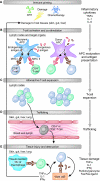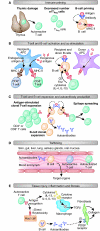Mouse models of graft-versus-host disease: advances and limitations
- PMID: 21558065
- PMCID: PMC3097454
- DOI: 10.1242/dmm.006668
Mouse models of graft-versus-host disease: advances and limitations
Abstract
The limiting factor for successful hematopoietic stem cell transplantation (HSCT) is graft-versus-host disease (GvHD), a post-transplant disorder that results from immune-mediated attack of recipient tissue by donor T cells contained in the transplant. Mouse models of GvHD have provided important insights into the pathophysiology of this disease, which have helped to improve the success rate of HSCT in humans. The kinetics with which GvHD develops distinguishes acute from chronic GvHD, and it is clear from studies of mouse models of GvHD (and studies of human HSCT) that the pathophysiology of these two forms is also distinct. Mouse models also further the basic understanding of the immunological responses involved in GvHD pathology, such as antigen recognition and presentation, the involvement of the thymus and immune reconstitution after transplantation. In this Perspective, we provide an overview of currently available mouse models of acute and chronic GvHD, highlighting their benefits and limitations, and discuss research and clinical opportunities for the future.
Figures


References
-
- Albert M. H., Liu Y., Anasetti C., Yu X. Z. (2005). Antigen-dependent suppression of alloresponses by Foxp3-induced regulatory T cells in transplantation. Eur. J. Immunol. 35, 2598–2607 - PubMed
-
- Alousi A. M., Weisdorf D. J., Logan B. R., Bolanos-Meade J., Carter S., Difronzo N., Pasquini M., Goldstein S. C., Ho V. T., Hayes-Lattin B., et al. (2009). Etanercept, mycophenolate, denileukin, or pentostatin plus corticosteroids for acute graft-versus-host disease: a randomized phase 2 trial from the Blood and Marrow Transplant Clinical Trials Network. Blood 114, 511–517 - PMC - PubMed
-
- Anderson B. E., McNiff J. M., Jain D., Blazar B. R., Shlomchik W. D., Shlomchik M. J. (2005). Distinct roles for donor- and host-derived antigen-presenting cells and costimulatory molecules in murine chronic graft-versus-host disease: requirements depend on target organ. Blood 105, 2227–2234 - PubMed
-
- Antin J. H., Weisdorf D., Neuberg D., Nicklow R., Clouthier S., Lee S. J., Alyea E., McGarigle C., Blazar B. R., Sonis S., et al. (2002). Interleukin-1 blockade does not prevent acute graft-versus-host disease: results of a randomized, double-blind, placebo-controlled trial of interleukin-1 receptor antagonist in allogeneic bone marrow transplantation. Blood 100, 3479–3482 - PubMed
Publication types
MeSH terms
LinkOut - more resources
Full Text Sources
Other Literature Sources

